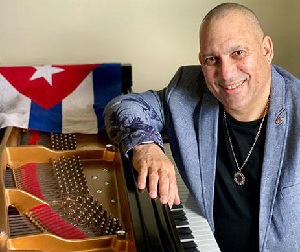 The pianist combines traditional Cuban styles, especially the rhythms of montunos and tumbaos, with jazz and classical music. Ignacio Herrera, Nachito, is a man of bridges, linking the music of Cuba, his native country, and the United States, where he resides. But he is clear about his origins. He comes and goes, again and again, to his roots, and dialogues with music other than his own. This is why the title of his most recent album, Con sentimiento cubano (With Cuban feeling,) is a profession of faith, a declaration of principles.
The pianist combines traditional Cuban styles, especially the rhythms of montunos and tumbaos, with jazz and classical music. Ignacio Herrera, Nachito, is a man of bridges, linking the music of Cuba, his native country, and the United States, where he resides. But he is clear about his origins. He comes and goes, again and again, to his roots, and dialogues with music other than his own. This is why the title of his most recent album, Con sentimiento cubano (With Cuban feeling,) is a profession of faith, a declaration of principles.
Likewise, by crowning that phrase with another, Patria o Muerte (Homeland or Death), he confirms the fullness of his sense of belonging to a people that since the 19th century to date has fought tooth and nail for its freedom, its sovereignty and its identity, facing countless dangers, threats of annexation and attacks against its national integrity. It is, at the same time, a response to those who have attempted to denaturalize the essence of Cuban art and, in a servile manner, played the game of pandering to illegitimate interests.
Con sentimiento cubano: Patria o Muerte, a disc by Colibrí Productions, was presented May 27 in Havana, during an event featuring its protagonists in both Cuba and the United States.
The album includes nine tracks of works by Juan Sebastian Bach, Federico Chopin, Serguei Rachmaninov, Alejandro García Caturla, Ernesto Lecuona, Frank Fernández, Emiliano Salvador and Herrera himself, responsible for the orchestrations and performing on piano, accompanied by the National Symphony Orchestra conducted by Enrique Pérez Mesa, and the Havana Jazz Social Club band. Aurora and Nachito Herrera were in charge of the production, recorded by Giraldo García in Egrem studios, under the supervision of Gloria Ochoa.
The artist’s goal is not surprising to anyone knowledgeable of Nachito’s career as a pianist, composer and arranger, beginning with his rigorous academic studies on the island culminating with his graduation from the University of the Arts; the lessons he received from Rubén González, a great pianist long before his stellar performances with the Buena Vista Social Club; his debut as a child with the National Symphony; the experience he acquired during his time with the Cabaret Tropicana orchestra, and his participation in developing the very Cuban project, and as a distinguished guest of the Afro Cuban All Stars, the latter two of vast international scope.
His U.S. experience includes invitations from the Minnesota Orchestra, The Wayzata Symphony, the Naples Philharmonic Orchestra, Chippewa Valley Symphony, and University of Wisconsin-Eau Claire Big Band, and meetings and collaborations with Chick Corea, Michael Tainer, Tito Puente and Giovanni Hidalgo, among others.
When asked about his piano concept, Nachito says: “I love all kinds of music, especially American music, but I like Cuban music the most… I like to combine traditional Cuban styles, especially the rhythmic approaches of montunos and tumbaos, with jazz and classical themes. That’s the way I see the evolution of Cuban piano.”
This album is not only a clear demonstration of this credo, but an expression of how he has taken this principle to its most fertile and exciting consequences.
(Taken from Granma)